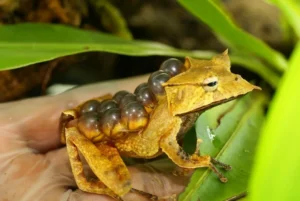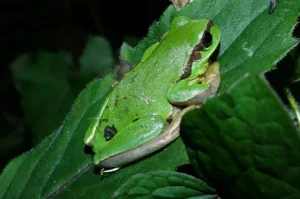Many people know that most frogs lay eggs, which then hatch into tadpoles, which metamorph into mature frogs over time. But tree frogs spend most of their time in or around trees, and live a lifestyle that is different from most other frogs.
The majority of tree frog species lay eggs. These eggs are typically laid in the water and attached to submerged vegetation near the water surface – or on plants hanging over ponds.
Some tree frog species such as the common coqui lay their eggs on plants away from water and even in abandoned bird nests.
Since common coquis lay their eggs away from water, their young bypass the tadpole stage and develop within their eggs until they hatch into froglets (baby frogs).
Most Tree Frog Species Lay Eggs
Reproduction in the vast majority of tree frog species involves the laying of eggs. The eggs are laid either in water, on plants hanging over the water, or in moist environments on land.
As a general rule, frog eggs require moisture to develop and hatch successfully.
For this reason, tree frogs such as the common coqui that lay their eggs on land, away from the water, provide moisture for their eggs by brooding them.
The skin contact keeps the eggs moist – and during very dry periods, these frogs will leave and head to the water to gather more moisture for their eggs.
Where Do Tree Frogs Lay Their Eggs?
Most tree frog species lay their eggs in the water. This could be in fishless ponds, spring-fed pools, flooded ditches, bogs, and other wetlands, puddles that collect in the holes of trees, or water-holding plants such as bromeliad plants.

The eggs are typically laid in masses – and those that are laid in ponds are attached to twigs or other vegetation slightly below or on the water’s surface.
Other tree frog species lay their eggs on the leaves of plants hanging over water – after the tadpoles hatch, they simply fall into the water.
A few tree frog species such as the gray foam-nest tree frog of southern Africa and the Fourlined tree frog of Southeast Asia lay their eggs in a foam “nest”.
This nest is built on branches or leaves overhanging a pond. When the tadpoles hatch, they will wriggle down the foamy secretion and plop into the water below.

Some tree frogs such as the Rio Grande chirping frog are and the Red-eyed coqui known to lay their eggs in damp leaf litter or moist soil on land.
Poison dart frogs live in forested areas without many sources of permanent water, so most dart frogs lay their eggs on the forest floor, hidden beneath the moist leaf litter.
Some also lay their eggs on moist leaves or in bromeliad plants with collected rainwater.
Below is a table that shows where 30 tree frog species lay their eggs.
Tree Frog Species |
Scientific Name |
Where They Lay Their Eggs |
| Gray tree frog | Hyla versicolor | Shallow standing water |
| Cope’s gray tree frog | Hyla chrysoscelis | Shallow standing water |
| Spring peeper | Pseudacris crucifer | Shallow standing water |
| American green tree frog | Hyla cinerea | Shallow standing water |
| Cuban tree frog | Osteopilus septentrionalis | Shallow standing water |
| Pacific tree frog | Pseudacris regilla | Shallow standing water |
| Poison dart frog | Dendrobatidae | In moist leaf litter or on moist leaves |
| Glass frog | Centrolenidae | On leaves hanging over a stream |
| Red-eyed tree frog | Agalychnis callidryas | On leaves hanging over a pond |
| Amazon milk frog | Trachycephalus resinifictrix | In water-filled hollows in trees or bromeliads |
| Common Mexican tree frog | Smilisca baudinii | Shallow standing water |
| Pine woods tree frog | Hyla femoralis | Shallow standing water |
| Barking tree frog | Hyla gratiosa | Shallow standing water |
| Squirrel tree frog | Hyla squirella | Shallow standing water |
| Australian green tree frog | Litoria caerulea | Shallow standing water |
| European tree frog | Hyla arborea | Shallow standing water |
| Blanchard’s cricket frog | Acris blanchardi | Shallow standing water |
| Southern cricket Frog | Acris gryllus | Shallow standing water |
| Northern cricket frog | Acris crepitans | Shallow standing water |
| Pine Barrens tree frog | Dryophytes andersonii | Shallow standing water |
| Sierran tree frog | Pseudacris sierra | Shallow standing water |
| Boreal chorus frog | Pseudacris maculata | Shallow standing water |
| Bird-voiced tree frog | Hyla avivoca | Shallow standing water |
| Mountain chorus frog | Pseudacris brachyphona | Shallow staning water |
| Little grass frog | Shallow standing water | Shallow standing water |
| New Jersey chorus frog | Pseudacris kalmi | Shallow standing water |
| Common coquí | Eleutherodactylus coqui | On palm tree leaves and other plants away from water – or in abandoned bird nests |
| Red-eyed coqui | Eleutherodactylus antillensis | In damp leaf litter or moist soil on land |
| Rio Grande chirping frog | Eleutherodactylus cystignathoides | In moist soil on land |
| Gray foam-nest tree frog | Chiromantis xerampelina | In foam “nests” built on branches or leaves overhanging ponds |
What Do Tree Frog Eggs Look Like?
Most tree frogs lay their eggs in the water, in masses, small clusters, or singly – or in small clusters on leaves above water. The eggs typically look like clear jelly-like globs, with a developing embryo visible inside each egg.
The embryos usually appear as small dots inside each egg – and when close to hatching well-developed tadpoles are visible inside each egg.
Here is what the eggs of a few tree frogs look like:



How Long Do Tree Frog Eggs Take to Hatch?
Different species of tree frog species have adapted to their environment and developed breeding methods that are practical for the areas they live in.
How long the eggs of a particular tree frog take to hatch can vary between species. The eggs of most tree frog species hatch within three weeks, but some can take even longer than that.
Here is a table that shows approximately how long 30 tree frog species take to hatch.
Frog Species |
Scientific Name |
How Long Their Eggs Take to Hatch (Days) |
| Gray tree frog | Hyla versicolor | 3 – 7 |
| Cope’s gray tree frog | Hyla chrysoscelis | 3 – 7 |
| Spring peeper | Pseudacris crucifer | 4 – 15 |
| American green tree frog | Hyla cinerea | 4 – 14 |
| Cuban tree frog | Osteopilus septentrionalis | 1 – 2 |
| Pacific tree frog | Pseudacris regilla | 14 – 35 |
| Poison dart frog | Dendrobatidae | 10 – 18 |
| Glass frog | Centrolenidae | 9 – 30 |
| Red-eyed tree frog | Agalychnis callidryas | 4 – 8 |
| Amazon milk frog | Trachycephalus resinifictrix | 1 – 2 |
| Common Mexican tree frog | Smilisca baudinii | 1 – 2 |
| Pine woods tree frog | Hyla femoralis | 1 – 3 |
| Barking tree frog | Hyla gratiosa | 5 – 10 |
| Squirrel tree frog | Hyla squirella | 1 – 2 |
| Australian green tree frog | Litoria caerulea | 1 – 2 |
| European tree frog | Hyla arborea | 10 – 14 |
| Blanchard’s cricket frog | Acris blanchardi | 6 – 21 |
| Southern cricket Frog | Acris gryllus | 4 – 6 |
| Northern cricket frog | Acris crepitans | 4 – 6 |
| Pine Barrens tree frog | Dryophytes andersonii | 3 – 4 |
| Sierran tree frog | Pseudacris sierra | 10 – 14 |
| Boreal chorus frog | Pseudacris maculata | 10 – 18 |
| Bird-voiced tree frog | Hyla avivoca | 3 – 4 |
| Mountain chorus frog | Pseudacris brachyphona | 6 – 10 |
| Little grass frog | Pseudacris ocularis | 1 – 2 |
| New Jersey chorus frog | Pseudacris kalmi | 1 – 2 |
| Mediterranean tree frog | Hyla meridionalis | 8 – 10 |
| Italian tree frog | Hyla intermedia | 10 – 14 |
| Common coquí | Eleutherodactylus coqui | 17 – 26 |
| Gray foam-nest tree frog | Chiromantis xerampelina | 4 – 6 |
Some Tree Frogs Have Unique Breeding Behaviors
With over 800 species of tree frogs around the world, there are bound to be a few that stick out as being weird.
Here are a few tree frogs with weird breeding strategies.
1. Horned Marsupial Frog
Horned marsupial frogs are found in Colombia, Costa Rica, Ecuador, and Panama. These frogs breed by direct development, which means they do not have a free-living tadpole stage.
The female frog releases eggs from her body, which the male then fertilizes, and deposits in a pouch on the female’s back. She then carries the eggs around – which fully hatch as fully developed frogs.

2. Banded Horned Tree Frog
Like the horned marsupial tree frog, the eggs of Banded horned tree frogs are carried in a pouch on the mother’s back and hatch into fully developed frogs.

Banded horned tree frogs are found in northwestern Ecuador.
3. Jerdon’s Tree Frog
Jerdon’s tree frogs are found in northeastern India. These frogs lay their eggs on the insides of tree hollows, which hold pools of water.
These hollows don’t contain enough food for developing tadpoles, so the females lay unfertilized eggs for their tadpoles to eat until they turn into froglets.

This is called “oophagy” and is one of the adaptations that many amphibians have developed to survive in harsh environments.
A Few Tree Frog Species Give Birth to Live Young
A few tree frog species such as the Golden coquí found in Puerto Rico do not lay eggs, but instead give birth to live young.

When Golden coquís mate, their eggs are fertilized internally and are retained within a uterus formed of fused portions of the oviducts.
The developing embryos are nourished by the egg yolks, and after about a month, the female will give birth to 3 – 6 fully developed frogs. This is known as “Ovoviviparity.”
Conclusion
All tree frog species lay eggs. In North America, the majority of tree frogs lay their eggs in shallow water, and attach them to submerged vegetation just below the water surface.
Some tree frog species such as the red-eyed tree frog and the glass frog lay their eggs on the leaves of plants hanging over water – after the tadpoles hatch, they simply fall into the water.
Other tree frog species such as the common coqui lay their eggs on plants away from water and even in abandoned bird nests. Their offspring do not have a tadpole stage, and hatch as fully terrestrial froglets.

